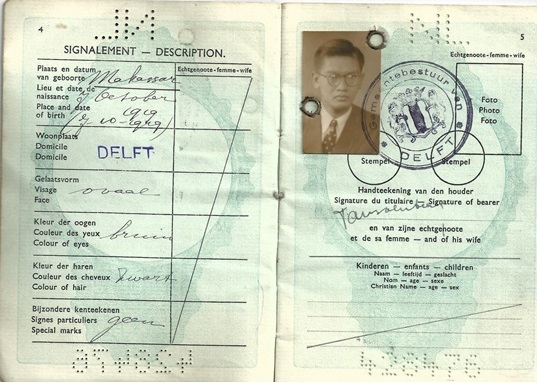Snapshots with Stories
25 – My father’s passport

My father was born in Makassar in 1919 and grew up in Surabaya. I do not know precisely when he went to Holland to study at the Technical University in Delft. I would guess it was about 1936, if he were 17 or 18 years old when he began his studies.
Before me lies his passport with a nostalgic black cover, which I found among his papers. It is the only passport that he kept and I wonder why. The passport was issued on 28 July 1938 by the municipality of Delft. In the photograph, with a serious expression he looks off to his right as if looking into the future; a boy still, despite of the stern looking spectacles, the white shirt and the proper tie.
The name on the passport is Soen Hong Tan. He is ‘Nederlandsch Onderdaan’ (‘Dutch citizen’) and is allowed to travel through ‘Europe and other parts of the world’. The passport is valid until 27 July 1940. Given the number of immigration stamps, I can tell that my father loved traveling. He visited Switzerland, Italy, England and Germany.
When he lost both his father and mother within a short period of time, he had to hurry back to Surabaya. I never knew before how complicated and time consuming his return trip must have been. However, I can now track the journey by the stamps in his passport. On 26 January 1940 he was given a transit visa by the British embassy in The Hague ‘Good only for direct transit through Iraq en route to Netherlands East Indies’ and ‘All British Aerodromes en route through to Netherlands East Indies’. The French consulate issued a ‘Visa de transit sans arrêt valable pour un seul voyage, aller en Italie. Se rond à Naples en transit par la France, Feignies, Modane’ (Non-stop transit visa, valid only for a single journey to Italy. Destination Naples, transit through France, Feignies, Modane)
Since he crossed the French-Belgian border at Feignies on 4 February, and the French-Italian border at Modane on the following day, it is possible that my father started out around 3 February. A number of illegible Arabic stamps further, on 9 February, he travelled from Karachi to Jodhpur in India. Dated 10 February is a stamp of the Burmese police in Rangoon, from where he traveled on to Dum Dum Aerodrome. He left for Thailand and landed in Don Muang on 11 February. After this there are no more stamps. It probably took him another day or two to reach his parental home. The whole journey might have taken about 10 days.
In my imagination I see my father hop, skip and jump over the Euro-Asian continent. What would have gone through his mind ? His two brothers and sisters were waiting for him, the eldest son, to take his place as head of the family. Three months before the European borders were closed, he arrived in Surabaya.
Amsterdam 1965. Gleaming with joy, my father entered the room. I have seldom seen him look so delighted. ‘We have just been given a Dutch passport!’. When my father took us to Europe in 1958, we spent one year waiting in Germany and Belgium before we were permitted to enter the Netherlands. We had renounced our Indonesian nationality and were traveling on a pink-colored passport for legal aliens. We finally received our Dutch passport after being stateless for 5 years. Although a passport is only a travel document, it is synonymous to citizenship in everyday language.
For my sisters and me acquiring the Dutch nationality was just a matter of course; we never gave it a second thought. It is only now that I understand how suspenseful the years of waiting must have been for my father. I also realize that it was in fact the second time that he became a Dutch subject; indeed I’m holding the evidence in my hands now. Perhaps my father was proud of his passport. It must have been of great sentimental value to him, a very likely reason why he never threw it away.
Ing Lwan Taga-Tan, August 2014


